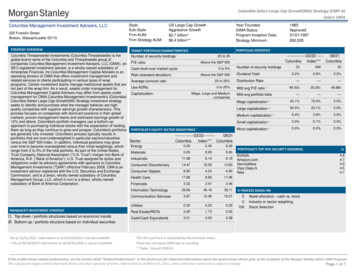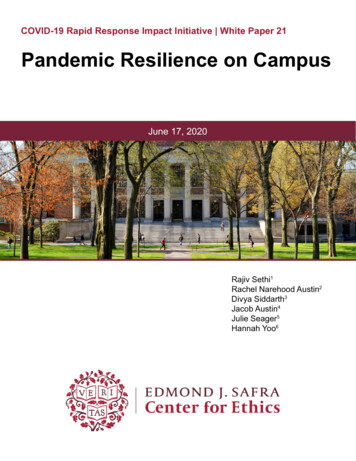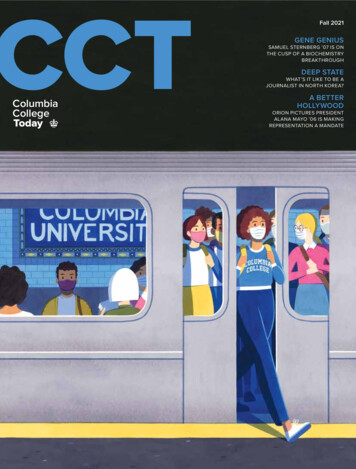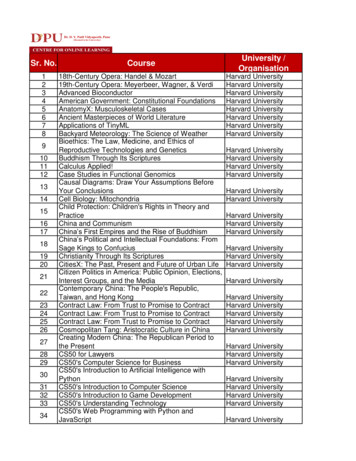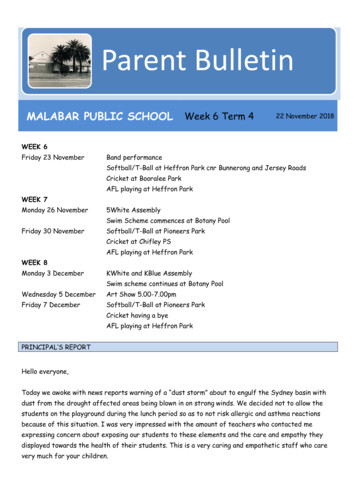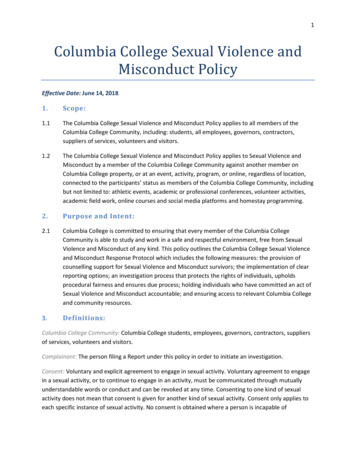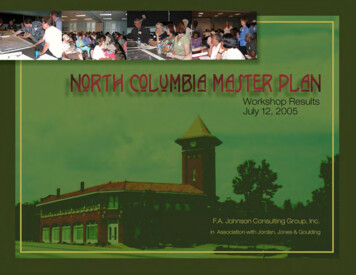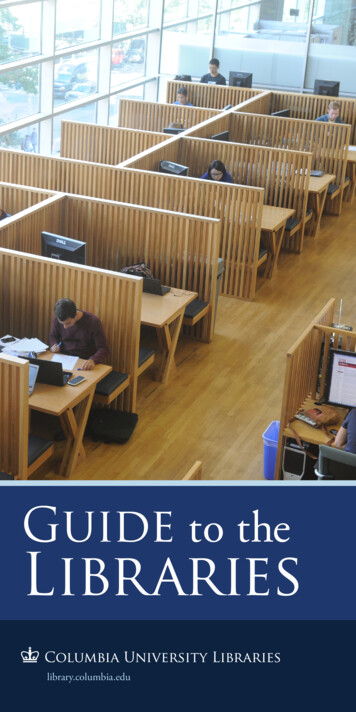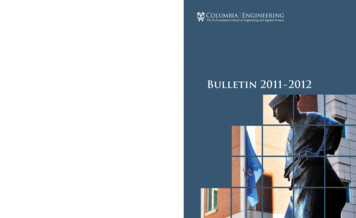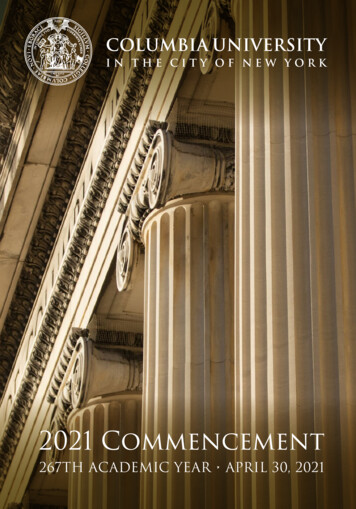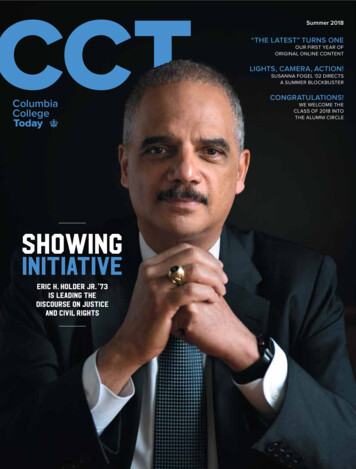
Transcription
Summer 2018“THE LATEST” TURNS ONEOUR FIRST YEAR OFORIGINAL ONLINE CONTENTLIGHTS, CAMERA, ACTION!SUSANNA FOGEL ’02 DIRECTSA SUMMER ic H. Holder Jr. ’73is leading thediscourse on justiceand civil rightsCONGRATULATIONS!WE WELCOME THECLASS OF 2018 INTOTHE ALUMNI CIRCLE
Nearly 100 years ago, Columbia College altered the landscape ofAmerican higher education with a pioneering experimentnow known as the Core Curriculum.Today, the Core to Commencement campaign — the College’s first-ever— seeks to create other life-altering experiences for our students and thefaculty who teach them. Join us in the next phase of this ambitiousendeavor to make Columbia College the greatest undergraduateexperience possible — one that we will all take pride in.The Core at 100Wellness andCommunityBeyond theClassroomTeaching mpaign@columbia.eduAccess andSupport
ContentsCCTColumbiaCollegeTodayVOLUME 45 NUMBER 4SUMMER 2018EDITOR-IN- CHIEFAlexis Boncy SOA’11263016features16True BlueEric H. Holder Jr. ’73, LAW ’76 leads a social justice initiativehe calls “a love letter” to the College and the country.By Jill C. Shomer20“The Latest” Turns One!Selections from our first year of original digital content.EXECUTIVE EDITORLisa PalladinoDEPUT Y EDITORJill C. ShomerASSOCIATE EDITORAnne-Ryan Heatwole JRN’09FORUM EDITORRose Kernochan BC’82ART DIRECTOREson ChanPublished quarterly by theColumbia College Office ofAlumni Affairs and Developmentfor alumni, students, faculty, parentsand friends of Columbia College.ASSOCIATE DEAN,COLUMBIA COLLEGEALUMNI RELATIONSAND COMMUNICATIONSBernice Tsai ’96ADDRESSColumbia College TodayColumbia Alumni Center622 W. 113th St., MC 4530, 4th Fl.New York, NY 1002526PHONEIn the Director’s ChairEMAILSusanna Fogel ’02 makes a summer blockbuster her way.By Phil Wallace ’0430Graduation 2018Caps, gowns, lions — check! Columbia’s newest alumni arewelcomed with speeches, interviews and more.Cover: Photograph by Rayon umbia.edu/cctISSN 0572-7820Opinions expressed are those ofthe authors and do not reflectofficial positions of Columbia Collegeor Columbia University. 2018 Columbia College TodayAll rights reserved.
Contentsalumni newsdepartments3 Message from Dean James J. ValentiniThis year’s Class Day message introduces aframework for reflection.4 Letters to the Editor38 Message from CCAA PresidentMichael Behringer ’89Encouraging student-alumni connections.39 LionsSteven Waldman ’84; Andrea Young ’06, GSAS’12;plus other alumni newsmakers.6 The Big Picture8 Around the Quads42 BookshelfMy Columbia College Journey encouragesstudents to think holistically about theirpersonal development.Feast: True Love in and out of the Kitchen,by Hannah Howard ’09.44 Class Notes13 Roar, Lion, RoarThe Lions reclaim their place among thenation’s elite fencing programs.Just Married!83 ObituariesSteven P. Marcus ’48, GSAS’61;Lawrence K. Grossman ’5234 Columbia Forum: The King Is AlwaysAbove the People by Daniel Alarcón ’99Ten short stories explore gritty themes.88 The Last WordThe Class of 2018’s president says goodbyeto the College.THINK TANK MAY 31Now on CCT OnlineCCTPRINT EXTRAS Reunion 2018 Facebook albums Graduation 2018 Facebook albums Academic Awards and PrizesLike Columbia College Alumnifacebook.com/alumniccView Columbia College alumni photosinstagram.com/alumniofcolumbiacollegeFollow @Columbia CCAAJoin the Columbia College alumni .columbia.edu/cctTHE LATESTTAKE FIVE APRIL 20“Anyone who met me in thefirst few weeks will tell youthat I was agonizingly loudand annoying. Thankfullyit didn’t take me too long torecognize that at Columbiaeveryone had somethingmarvelously interesting toshare about themselves, andthat I would gain a lot more byjust shutting up and listening.”— Aspiring attorney Ankeet Ball ’16“I was working at McDonald’s inmy hometown of Needham, Mass.I wanted to be an intern at theNeedham Times. I cold-called theeditor-in-chief, and she said no.Then I just walked into her officeand handed her my clips fromSpectator. She said no. I visitedher a second time. This time shesaid yes. She said she always didthat with job applicants — said nobefore she said yes — becausetenacity is an important trait forjournalists. She was right!”— CNN correspondent Elizabeth SchwartzCohen ’87, from “What Do You RememberMost About Your First Summer Job?”
Message from the DeanIn Pursuit of “Eudaimonia”Isaid to you at Convocation 2014 that what you did from thatday forward would define your Columbia College experienceand bring you here to Class Day. Each of you brought a special personal story, a story of the path by which you arrivedat Columbia. You were then at the beginning of your ColumbiaCollege journey.I am sure you have had days of jubilation — perhaps not as greatas today — but still, days of triumph. But I am also sure you haveexperienced setbacks, and you have had to pivot in response. Andyou have found that the path may not always be straight and predictable, but that it can lead to success in ways that, though not atall predictable, are no less satisfying.During these days at Columbia College you not only gainedknowledge, but also developed critical thinking and research abilities; refined your written and oral communication skills; improvedyour quantitative, information and technological literacy; engagedin teamwork and collaboration; expanded your creativity and innovation; took on civic and individual responsibility; participated incommunity engagement and inclusion; built global awareness; andencouraged all of us to foster a sense of wellness and resilience. Inshort, you developed your Core Competencies, even before youknew that phrase or could name its components.While the narrative of “My Columbia College Journey” wasintroduced to you only a month ago, you were on your very ownindividual Columbia College Journey from the moment you arrivedhere, without realizing it. What has changed is the self-awarenessof that journey, a self-awareness that you will have many years tobenefit from.The word “journey” derives from the Latin diurnus, meaningday by day or daily. And though you are graduating, it is still yourColumbia College journey, because Columbia College is now a fundamental part of you, and your experience here will forever influence your path. The road goes on, paved with Pantone 292 and allthat that color represents.“Jubilation” derives from Latin as well, and refers to a very vocalkind of joy, with wild and loud shouting of great enthusiasm, loudshouting I am certain I am going to hear at this ceremony. Everyday, however, can’t be like this one; every day can’t be cause for loudshouting of great joy. But, every day can be a source of satisfaction andfulfillment and meaning. You will notice I did not say “happiness.” Idid not, because happiness is not the object to pursue. You know that,PHOTOS BY EILEEN BARROSOAt Class Day on May 15, I spoke about My Columbia College Journey,a recently introduced framework for students to reflect on their growthand experiences during their time at the College. [Read more about theJourney on page 8.] What follows is an abridged version of my speech. Toour most recent graduates, who now receive Columbia College Today,congratulations again, and welcome to the community of more than51,000 Columbia College alumni.and you know what is to be pursued, because it is part of the CoreCurriculum experience of every student. It is eudaimonia.Eudaimonia is to be found when you plot your own trajectory,when you build on what you have learned here to be active andengaged citizens, responsible and valuable members of the manycommunities — personal and professional, large and small — ofwhich you will be part.Eudaimonia means much more than simply faring well or beingsuccessful, the outcomes with which “happiness” is associated. Eudaimonia is the essence of My Columbia College Journey: a personal,individual, unique path to flourishing, substance and meaning in life.Many things will interfere with, even preclude, the simple thingcalled “happiness” — events you can’t influence and people you can’tpersuade. But the eudaimonia of yourjourney is indeed yours, so focus on it.We admitted you to Columbia Col- CCT Print Extraslege based on our belief that you were To view Valentini’s Classthe applicants who could best profit Day speech in full, go tofrom and contribute to Columbia Col- college.columbia.edu/cct.lege. I hope you have profited fromyour experience at the College. I know you have contributed to it,in classrooms, arenas, laboratories, residence halls and even on LowBeach. For all of that I thank you. All of us at Columbia Collegethank you.James J. ValentiniDeanSummer 2018 CCT 3
Letters to the EditorBARNEY EDMOND S GS’ 6 7 , SOA’ 6 9Left of CenterAn Overdue ApologyFor whatever it is worth so many years later, CCT readers might be interested toknow that I was given an apology from a NYPD official regarding police behaviorin clearing the “occupied” campus areas and buildings that haunting night in 1968.As a student back then in search of statistics to support an expository writing assignment about the 1968 Columbia riots, for Professor Michael RosenthalGSAS’67’s English class, I went downtown to police headquarters. I was directedto the private office of Benjamin Ward. I do not recall his rank, but he was “brass.”He looked serious. He asked me to close the door and be seated. What he said hasstayed with me ever since:“I do not usually speak with undergraduates,” he began, “but no one else from Columbia has come to me about this matter.” He went on to apologize for the actions of thepolice that horrible night. He knew they had been needlessly brutal, beating unconsciousand bleeding students. I never mentioned that I was a witness (not a protestor), standing only a few feet away from the harrowing confrontation on College Walk. He askedme to take his message back to campus. He wanted Columbia to know of his contritionand apology on behalf of the NYPD, and in particular its TPF [Tactical Police Force],who had taped over or removed their shields to conceal their identities and used brassknuckles and weighted clubs to beat dozens of unarmed students.I left in stunned silence with the statistics I requested. My paper was due the nextday. Then there were final exams. Then there was moving out at the end of the academic year. I had intended to go to Spectator’s office and share my story, but I never did.Time got away. And then I rationalized that it was all water under the bridge anyhow.Ward has since died. I looked him up recently. Evidently, he was well respected inthe NYPD. In light of CCT’s 50th anniversary articles on the subject, I thought hismemory and his apology ought to be recognized, even if a half-century late.John Kantor ’71Westport, Conn.4 CCT Summer 2018Paul Starr ’70, in his piece “How the ’68Uprising Looks Today” [Spring 2018], concludes rightly that the University needs tobe an open forum, facilitating, as he puts it,more “antagonistic confrontation,” whichmay come at the expense of “safe space.” ButI take issue with at least one of his statementsin arriving at that conclusion. Starr suggeststhat liberalism was under attack from the leftin ’68 and now is from the right. I fail to seehow liberalism is now under attack from theright when that is precisely the people whosevoices are being suppressed on campus.Rather, a more fundamental and relevantchange is that the “center,” if you will — theestablishment of the academy — has itselfshifted far left since ’68 and more closelyaligned with its students. As a result, I wouldsuggest liberalism, and in turn the University,is now most under attack from itself.The ’68 uprising might have been acatalyst for embracing certain substantive messages of the activists of ’68, but itwas perhaps also a catalyst for shifting thecenter of the University further left. In sodoing, the academy has not only shiftedthe spectrum of viewpoints to be found oncampus but has tolerated both an intolerance of other viewpoints, and the disobedience targeting those expressing them, inways that Martin Luther King Jr. wouldnot have tolerated. This silencing is attributable to the University itself, failing students who are left unprepared for a worldthat doesn’t always have safe spaces.Joshua Tenzer ’01Englewood, N.J.“Liberation Classes”CCT’s coverage of the 50th anniversary ofthe 1968 protests (Spring 2018, “50 YearsLater”) neglected to mention somethingimportant: During the student strike,classes went on. Columbia professors andtheir students kept on meeting to read,think and talk. My classmate Alan Sullivan’69 gives a good description of one of these“liberation classes” in the 1969 Class Notesin the same issue, and I remember meetingin Professor Howard Porter’s apartment toread Lucretius with Professor Steele Commager. Bulletin boards near the Sundialannounced times and locations.For perhaps the last time since the Middle Ages, the universitas — the corporate
body of students and teachers — removeditself from administrative control andmigrated in a body to carry on its essentialwork. Do today’s students and their professors have the same sense that readingand thinking about Matthew Arnold orLucretius can be as important and radicalas protests and petitions?Lee T. Pearcy ’69Merion Station, Pa.First ImpressionsJamie Katz ’72, BUS’80’s article in theSpring 2018 issue on the events of theSpring ’68 student uprising at Columbia[“A Tinderbox, Poised To Ignite”] waswell written and very informative. I wasunaware of the extent of the role of theStudents’ Afro-American Society and itsdisciplined confrontation of the Universityadministration, especially with respect tothe proposed gym to be built on part ofMorningside Park.Reading the details of the gym opposition reminded me of an experience I hadduring Freshman Week in fall 1952. WhenI arrived on campus, the first classmate Imet that day, during the initial freshmanprocessing activity, was Gordon Osmond’56. After finishing the process, he and Idecided to explore the campus and walkedto the president’s residence on Morningside Drive to look around. As we arrived,University President Dwight D. Eisenhower’s wife, Mamie, came out of thehouse to enter her limousine. She saw us,and graciously said hello and welcomed usto Columbia.After the limo drove away, we decidedto cross the street and look at MorningsidePark. After gazing across the park to WestHarlem, we looked down at the park at thebottom of the cliff. There we saw a blackman, spread-eagled, facing the stone wallof the cliff, while being searched by a whiteNYC policeman.Welcome to Morningside Heights.Jerome Breslow ’56Potomac, Md.’68’s Collateral DamageYou cannot report accurately on the impactof the 1968 riots at Columbia withoutunderscoring their impact on hundreds ofColumbia students who lost their educational opportunities because of the short-sighted, irresponsible acts of those rioterswho took over the campus and seized thepresident’s office. It was the symbol of ultimate arrogance when The New York Timesfeatured on page 1 a photo of Mark Rudd’69 sitting behind President Grayson Kirk’sdesk, smoking one of his expensive cigars.In the wake of all that happened, Columbia eliminated 80 full, four-year NROTCscholarships that provided tuition, room,board, uniforms, an allowance for mealsand a Navy commission upon graduation.From then on hundreds of students weredenied a Columbia education.Without NROTC, I would have hadno way of obtaining a college education.My scholarship and a superb Columbialiberal arts education changed my life.Commissioned in 1956, I served mostlyin the Pacific, returned to California andbegan my career in the newspaper business. In late 1968, I was tapped by thenSecretary of Defense Melvin Laird to serveas deputy assistant secretary of defense onthe Laird-Packard team. One of our firstacts was to eliminate NROTC programs atuniversities like Columbia that could notassure protection of academic freedoms forthose who chose to follow the NROTCprogram. We simply took the ROTCscholarship business elsewhere, to areas ofthe country where the program was welcomed, nurtured and served as the sourceof outstanding, well-educated leaders forour nation.Everyone lost because of damage doneby the rioters and by a University administration that lacked the courage to stand upfor the rights of all.Dick Capen ’56La Jolla, Calif.Editor’s note: The NROTC program is again inoperation at Columbia, having been reinstatedunder an agreement signed in May 2011; he quads3.Thank You for the MusicI just finished reading, with great pleasureand fondness, “Here’s to You, Mr. Garfunkel” [“Columbia Forum”] in the Spring2018 issue; it included an excerpt from ArtGarfunkel ’65’s new autobiography, What Is ItAll but Luminous: Notes from an UndergroundMan. I was a schoolmate of Art’s at the College, but unfortunately I never met him.I “met” him a few years later, in 1968,when I went to the Jayhawk Theatre inTopeka, Kans., the town where I grew up,to see The Graduate. I remember exactlywhere I sat alone in the balcony. I could nothelp but identify with Dustin Hoffman’scharacter, and I became engrossed in hisdilemma. But while watching the movie,something happened to me that had neverhappened before, nor was to happen to meagain: I slowly became mesmerized by themovie’s music. The songs were transcendent: “The Sound of Silence,” “Mrs. Robinson,” “Scarborough Fair,” “April ComeShe Will.” I had never heard songs thatbeautiful, and though I will soon be 74, Idon’t think I have ever since heard songsmore beautiful.I had danced to the sound of The Beatlesin front of Ferris Booth Hall, but in time,and forever after, I came to the realizationthat no other musical group could everequal Simon and Garfunkel. The tragedy,of course, is that Paul and Art broke upin 1970. I still listen to their famous 1983Central Park reunion concert, which drewhalf a million fans.Thank you, Art, for making my worldforever beautiful with your singing.Tod Howard Hawks ’66Boulder, Colo.CorrectionDue to an editing error, the wrong Bob Reisswas referenced in “Remembering All theChampions,” in the Spring 2018 “Letters tothe Editor.” Rather than the late Bob Reiss’51, PS’59, it was in fact Bob Reiss ’52 whoplayed on the excellent 1950–51 basketballteam — and he’s alive and well (and in goodhumor about the mix-up). CCT apologizesfor the error.Contact UsCCT welcomes letters from readersabout articles in the magazine but cannotprint or personally respond to all lettersreceived. Letters express the viewsof the writers and not CCT, the Collegeor the University. All letters are subjectto editing for space, clarity and CCTstyle. Please direct letters for publication“to the editor” via mail or online:college.columbia.edu/cct/contact-us.Summer 2018 CCT 5
theBigPictureREUNION REVELRYLion spirits were high at this year’s Starlight Celebration onJune 2, as 2,500 alumni and guests enjoyed the festivitiesbathed in Butler’s blue glow. Find party pics, class photos andmore Reunion 2018 snaps at facebook.com/alumnicc/photos.SCOTT RUDD6 CCT Summer 2018
Summer 2018 CCT 7
AroundtheQuadsDinner and discussion at theMy Columbia College Journeylaunch on April 9.MARYAM HASSAN ’20“ My Columbia College Journey” EncouragesHolistic View of Students’ DevelopmentFrom Dante’s travels through theafterlife to Odysseus’ post-warwanderings, Columbia Collegestudents are no strangers to contemplating the journeys that take place inliterature’s essential works.Now they’re being asked to consider onecloser to home: their own.That’s the goal of My Columbia CollegeJourney, a new initiative that encouragesundergraduates to reflect on their life at theCollege — and beyond — in real time. Itadvocates taking a holistic view of personaldevelopment rather than defining oneselfin academic terms. This more rounded viewencompasses what’s learned in the classroom(while deemphasizing grades and transcripts,or the urge to overly identify with a major),taking into account the lessons and influencesof extracurriculars, residential life, internships,research, community engagement and more.Ultimately the Journey aims to help students be more aware of their skills, their8 CCT Summer 2018interests and how they want to grow; makethoughtful decisions about their academicand co-curricular life; and understandand articulate the many ways the Collegeshapes them.“The Journey encourages you to see theinterconnectedness of your experiences forthe very first time, to examine all the possibilities your mind can envision and to askyourself questions that will focus on theprocess — not just the outcome,” DeanJames J. Valentini said to the nearly 300students who attended the Journey launchon April 9. Held in Low Rotunda, it featured discussion and a family-style dinnerwith staff and faculty members.The Journey has been more than three yearsin the making, having grown out of facultyconversations by the Committee on Instruction during the 2015–16 academic year. It isgrounded in a set of 13 “Core Competencies,” which are focal points for reflection andprovide a shared language for the entire Col-lege community to talk about their journeys.The competencies are civic and individualresponsibility; community engagement andinclusion; creativity and innovation; criticalthinking; global awareness; information andtechnological literacy; knowledge; oral communication; teamwork and collaboration;research; quantitative literacy; wellness andresilience; and written communication.While the initiative does not have anyrequired elements, students are encouragedto share their stories on the My ColumbiaCollege Journey website (college.columbia.edu/journey), which offers questions topromote reflection about each of the competencies and helps students find an advisor to help with the process.“Not all of what you learn is in class,”said Dustin Rubenstein, associate professor of ecology, evolution and environmental biology, at the launch. “It’s importantfor you to challenge yourself and get outside your comfort zone.”
College Expands Core to Commencement Campaignships to humanities fellowships and science experiences — havebeen secured.Looking ahead, the priority areas for the next phase of Core toCommencement are: The Core at 100: ensuring the Core Curriculum’s continuedrelevance with a focus on faculty engagement, interdisciplinary programming and contributions to the public domain to establish theCollege as a leader in liberal arts education; Beyond the Classroom: giving students hands-on experiencesthat expand their skills, worldviews and leadership abilities; Wellness and Community: supporting and challenging studentsto develop life skills, well-being and resilience; Teaching and Mentoring: attracting the best faculty and involvingthem in students’ lives while supporting their scholarly research; and Access and Support: creating access for students most ableto fully enjoy the potential of a College education and creating avibrant and diverse student cultureFor more information, go to college.columbia.edu/campaign.LIFETOUCH / DENIS GOSTEVColumbia College has announced the expansion of Core to Commencement, the first-ever fundraising and engagement campaigndedicated exclusively to the College. The next phase embraces fivepriority areas for support — including teaching and mentoring,and wellness and community — with an increased total goal of 750 million.More than 35,000 donors have contributed 422 million sincethe campaign launched in November 2015 with an original goal of 400 million. In the two and a half years since, the campaign helpedestablish the Mendelson Center for Undergraduate Business Initiatives and the Eric H. Holder Jr. Initiative for Civil and PoliticalRights. The former has made business concentrations available toundergraduates; the latter creates a distinctive undergraduate experience that allows students to address issues of inequity and injustice(see cover story, page 16).In addition, 130 million of the contributions have gone tofinancial aid, 14 endowed professorships have been established and1,000 funded experiences for students — from summer intern-A Toast to theClass of 2018Silver Stars!Our Fall 2017 cover story, “Star Power,” by Yelena Shuster ’09, won a Silver Awardfor feature writing from the Council for Advancement and Support of Education.Reporting on Brandon Victor Dixon ’03’s whirlwind of political fame impressedCASE judges: “ that unexpected twist elevated this story beyond a run-of-themill profile.”The CASE Circle of Excellence awards honor outstanding work in advancementservices, alumni relations, communications, fundraising and marketing at colleges,universities, independent schools and affiliated nonprofits. This year, almost 350awards were given to more than 190 institutions. Read the winning feature now atcollege.columbia.edu/cct/issue/fall17.On May 1, nearly 900 members of CC’18enjoyed dinner under a tent on South Lawnto mark their transition from students toalumni. Hosted by the Columbia CollegeAlumni Association, the annual ColumbiaCollege Senior Dinner is a beloved traditionfor seniors on their last day of classes. Theevent featured a welcome from ColumbiaCollege Student Council President NathanRosin ’18, as well as remarks from DeanJames J. Valentini, Senior Class PresidentJohn Philippe Avendano ’18 and SeniorDinner Co-chairs Vik Kapur ’18, StarlySofia Santos ’18 and Charlotte Silk ’18.Summer 2018 CCT 9
AroundtheQuadsCarnoy and Lavine Elected Trustee Co-ChairsOn April 18, Lisa Carnoy ’89 and Jonathan Lavine ’88 were elected as the new cochairs of the University Board of Trustees.Both come from a finance background andhave a long history of service to the College and the University. The two have beenfriends since they were RAs in Carman.Carnoy is a leader in global finance andcapital markets; she spent 23 years at Bankof America Merrill Lynch and is now thechief financial officer at Alix Partners.She has received a John Jay Award forprofessional achievement, the College’sAlumna Achievement Award and theUniversity’s Alumni Medal. Lavine is comanaging partner of investment firm BainCapital. He has also received a John JayAward for professional achievement, aswell as the Alexander Hamilton Medal,and is chairman emeritus of the ColumbiaCollege Board of Visitors.Says Carnoy, “I could not have a greaterhonor than to lead Columbia’s Board ofTrustees, and to do so together with mylongtime College friend and dedicatedfellow alum Jonathan.” Lavine adds, “Icould not be prouder to serve as co-chairwith my friend Lisa, and to have anotherDidYouKnow?SCOTT RUDDThe Pylons Flanking the116th Street Gates Were GoingTo Be a Set of FourOn June 2, 1915, the Class of 1890 presented a gift to the University to mark the occasion of its 25th reunion: the pylon namedLetters that now graces the right side of the 116th Street Gates atBroadway. From a 1915 issueof Spectator: “[Sculptor CharlesKeck] has represented Letters inthe form of a woman holding anopen book. The first page contains the inscription ‘Hic Labor,’while the second page read ‘HaecQuies.’ When freely translatedthis means: ‘Letters should be theemployment of our serious hoursas well as of our hours of leisure.’”The article continues, “This isthe first of a series of four similarpylons, to be placed on the fourcorners of 116th street betweenBroadway and Amsterdam. Across the street from Letters it isplanned to place Science to accompany the group of Engineeringbuildings situated there. On the Hamilton Hall corner Arts will beerected, while Philosophy will occupy the remaining space. Each ofthese pylons will cost about 9,000 and will be presented by differentclasses for their twenty-fifth anniversary gift.”In 1925, the Class of 1900 donated money for Science to joinLetters on Broadway; however, future classes lost interest in completing the quartet (possibly due to the Great Depression and thenWWII) and the Amsterdam pylons were never completed.10 CCT Summer 2018Lisa Carnoy ’89Jonathan Lavine ’88unique opportunity to give back to thisremarkable institution.”The two will take over in Septemberfrom outgoing chair Jonathan Schiller ’69,LAW’73, who has held the role since 2013.Faculty Honored forTeaching, WritingOn June 2, the Society of Columbia Graduates and thedeans of Columbia College and Columbia Engineeringbestowed the annual Great Teacher Awards on AssociateProfessor of Ecology, Evolution and Environmental BiologyDustin R. Rubenstein and Professor of Civil Engineeringand Engineering Mechanics Andrew Smyth.The Academic Awards Committee of Columbia College celebrated the student-nominated recipients of the 2018Lionel Trilling Book Award and Mark Van Doren Awardfor Teaching at a ceremony on May 2. Gareth Williams, theViolin Family Professor of Classics and chair, Departmentof Classics, was honored with the 43rd annual Lionel Trilling Book Award for his recent book, Pietro Bembo on Etna:The Ascent of a Venetian Humanist, chosen by the committeefor bringing “illuminating new perspective to another work ofliterature.” Gauri Viswanathan TC’85, the Class of 1933 Professor of English and Comparative Literature and director, theSouth Asia Institute, was honored with the 57th annual MarkVan Doren Award for Teaching “for the unmistakably globalscale of her thinking.”On April 11, eight faculty members were honored with Lenfest Awards for exceptional instruction and scholarship. The2018 recipients are Professor of Religion Courtney Bender;Associate Professor of English and Comparative LiteratureEleanor Johnson; the Frank Gallipoli Professor of Modernand Contemporary Art Branden W. Joseph; Professor ofBiological Sciences and Systems Biology Molly Przeworski;Senior Le
our most recent graduates, who now receive Columbia College Today, congratulations again, and welcome to the community of more than 51,000 Columbia College alumni. said to you at Convocation 2014 that what you did from that day forward would define your Columbia College experience and bring you here to Class Day. Each of you brought a spe-
